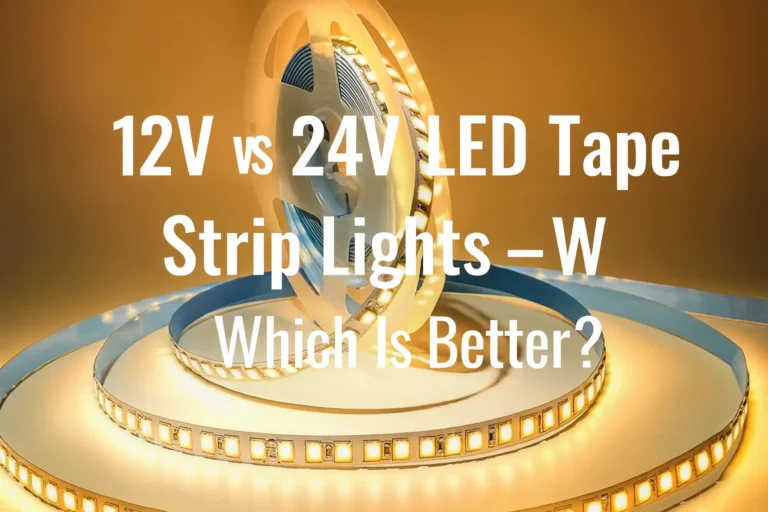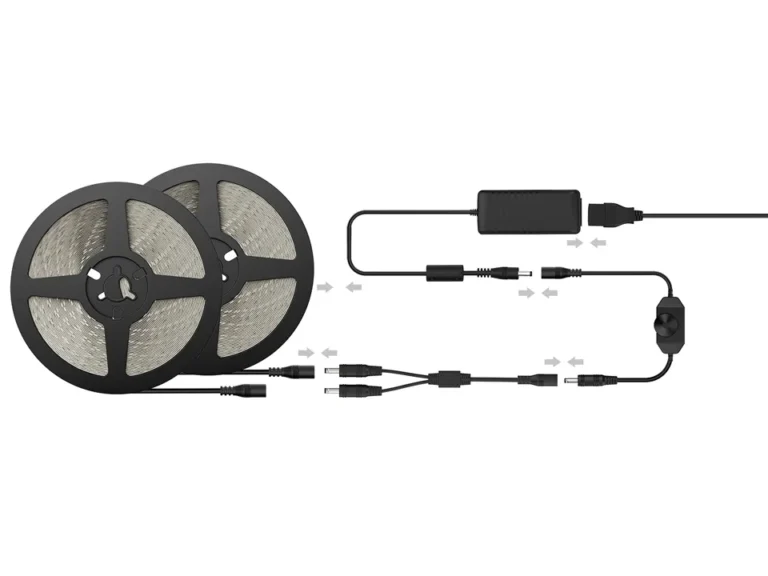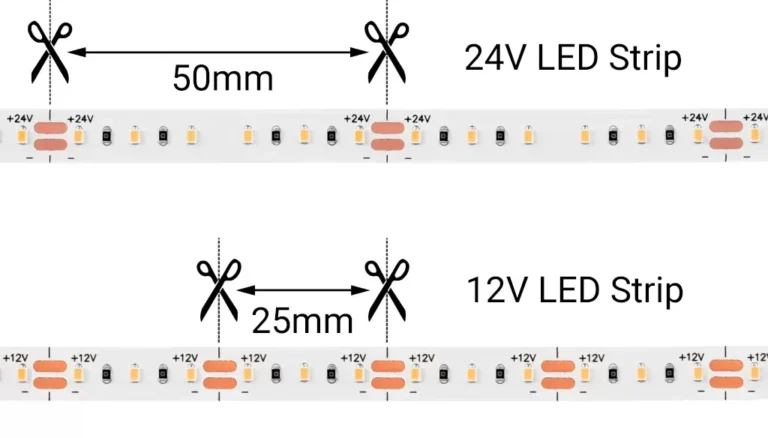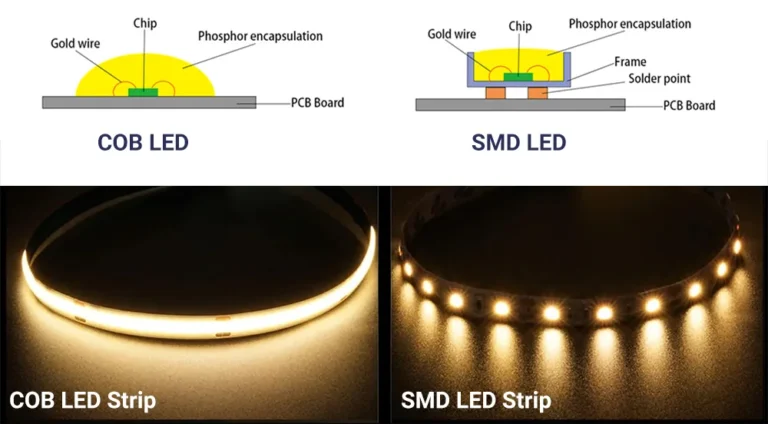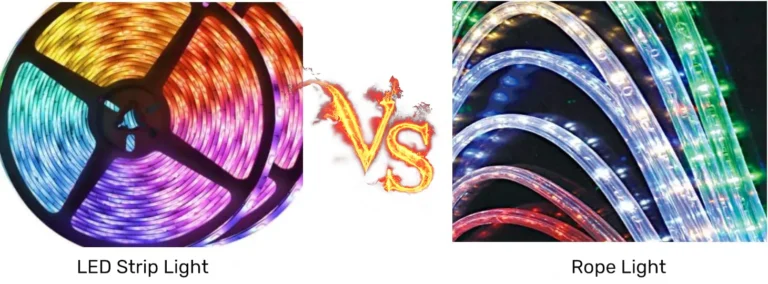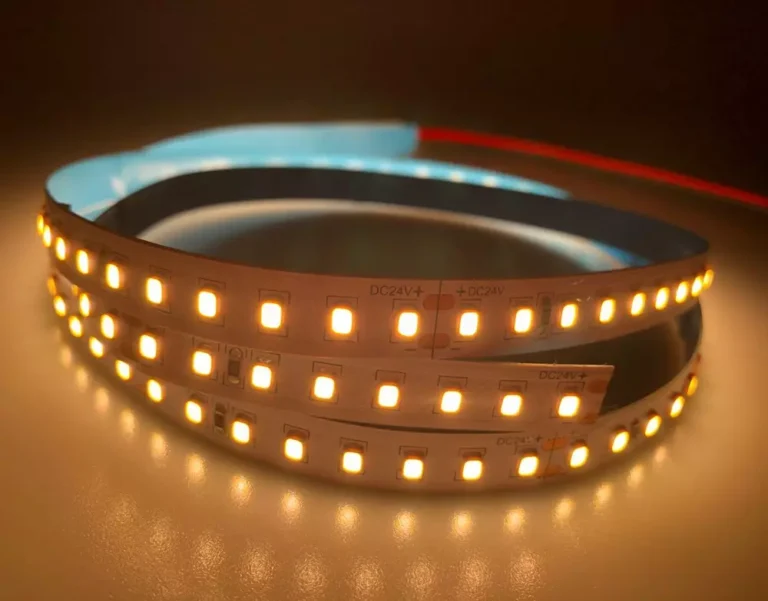comienzo
En Iluminación de tiras LED Las instalaciones, la selección de voltaje a menudo se subestima, pero afecta directamente la consistencia del brillo, la eficiencia energética y los costos de mantenimiento a largo plazo. Muchos instaladores han experimentado situaciones de frustración: tiras de LED que se atenúan a la mitad de una carrera o se necesitan fuentes de alimentación frecuentes después de la instalación. En la mayoría de los casos, estos problemas se deben a la elección del sistema de voltaje incorrecto: 12V, 24V o 48V. Para una comparación más profunda entre los dos voltajes más comunes, consulte nuestra guía completa: Luces de tira de 12 V vs 24 V LED: cómo elegir.
Elegir el voltaje correcto de la tira de LED es crucial para evitar la caída de voltaje, una pérdida de voltaje que ocurre cuando la corriente eléctrica viaja a través de la tira, lo que provoca un brillo desigual y energía desperdiciada. Los sistemas de mayor voltaje reducen la corriente para la misma potencia de salida, lo que minimiza la caída de voltaje y la acumulación de calor, especialmente en tramos largos.
Por ejemplo, las tiras de LED de 12 V ofrecen una alta flexibilidad y son ideales para proyectos de bricolaje de corto plazo; las tiras de LED de 24 V logran un gran equilibrio entre rendimiento y costo para carreras de longitud media; mientras que las tiras de 48 V LED sobresalen en instalaciones de larga distancia y proyectos de ingeniería a gran escala. Esta guía desglosará los conceptos básicos de voltaje, las diferencias de rendimiento y los mejores escenarios de uso, lo que le ayudará a elegir el voltaje de la tira de LED adecuado para cualquier proyecto de iluminación con confianza.

Comprender el voltaje de la tira de LED
Al seleccionar el voltaje de la tira de LED, es importante comprender la relación entre el voltaje y la longitud máxima de carrera para las luces de tira de LED.
Para tiras de LED de voltaje constante, se necesita un voltaje más alto significa menos corriente para entregar la misma potencia, lo que ayuda a reducir la caída de voltaje y mantener un brillo constante en toda la longitud de la tira.
Especificaciones típicas:
Tiras de 12 V LED: Mantener un brillo estable hasta unos 5 metros (16 pies); más allá de esta longitud, puede ocurrir una atenuación notable.
Tiras de 24 V LED: Comúnmente soportan recorridos de alrededor de 10 metros (33 pies), con algunas opciones de alta calidad que alcanzan hasta 15 metros.
Tiras de 48V LED: Puede correr de 15 a 20 metros (50 a 65 pies) o más; cuando se combina con un sistema de tira de LED de corriente constante, se pueden lograr longitudes de 30 a 40 metros (100 a 130 pies) o más.
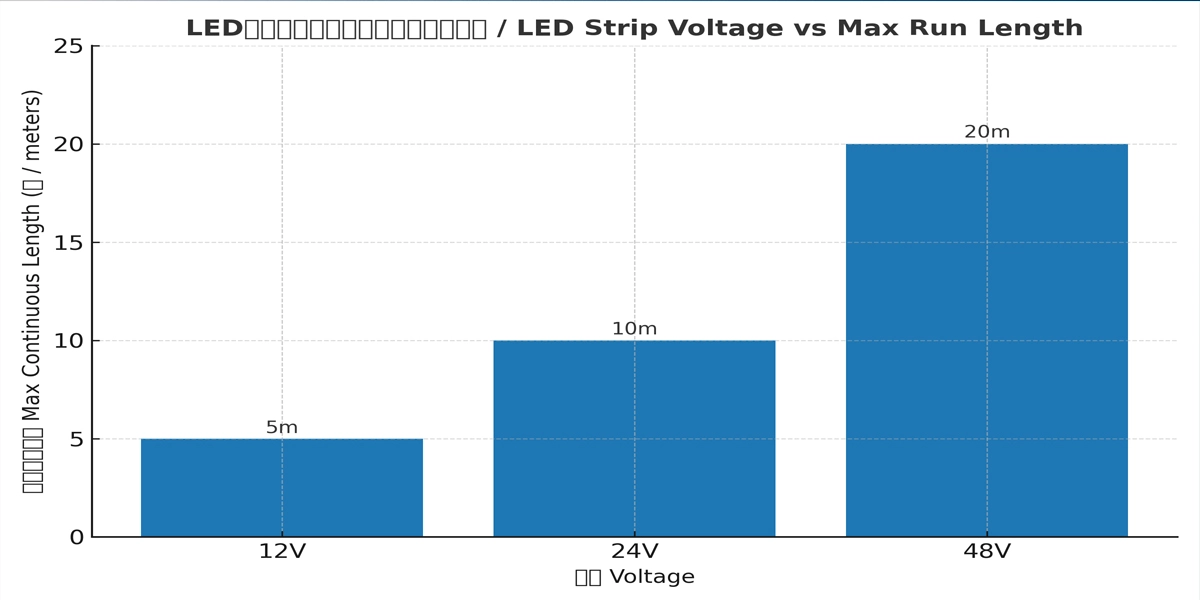
Otro concepto clave es el voltaje constante frente a la corriente constante:
Las tiras de LED de voltaje constante (como 12 V, 24 V, 48 V) utilizan una fuente de alimentación de voltaje fijo y son fáciles de instalar y controlar, pero son más propensos a la caída de voltaje en largas distancias.
Las tiras LED de corriente constante proporcionan una salida de corriente estable, lo que garantiza un brillo y una temperatura de color uniformes en longitudes extendidas, ideal para proyectos a gran escala que requieren el máximo rendimiento y consistencia.
Al comprender estos fundamentos, puede elegir el voltaje de la tira de LED correcto que equilibra la longitud de la instalación, la consistencia del brillo, la complejidad del cableado y el costo general, lo que garantiza la eficiencia y la calidad visual.
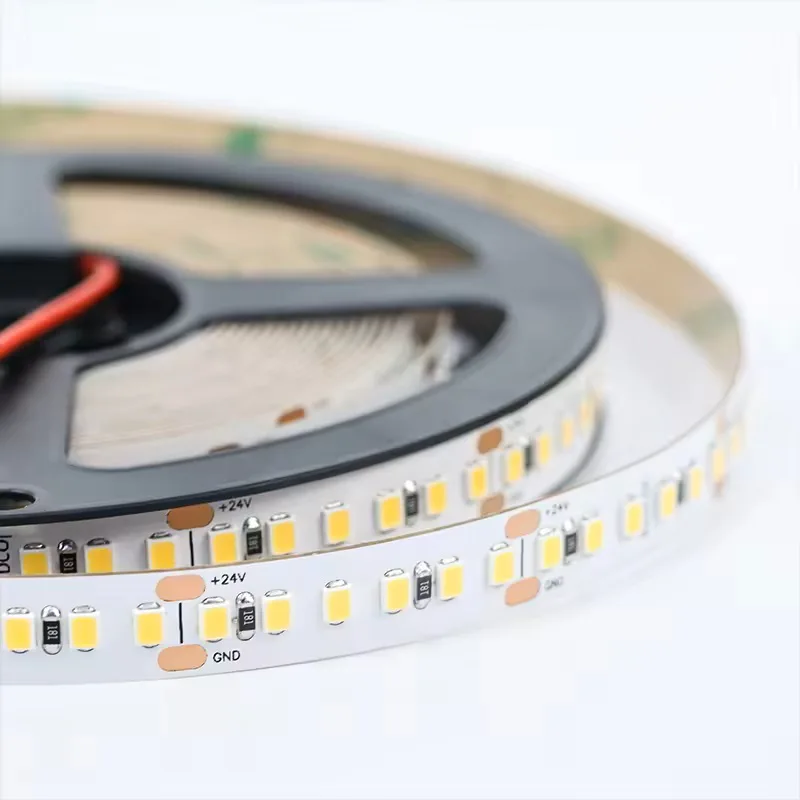
Cinta de luz LED SMD2835
Modelo principal: FQX08T120C
LED CANT. por metro Opción: 60/72/120/128/140
Opción de ancho de PCB: 6mm/8mm/10mm
Opción de color: 2700K/3000K/4000K/5000K/6500K
Opción CRI: 80/90
Voltaje de entrada: DC12V/DC24V
Potencia por metro: 6W/8W/9.6W/12W/14.4W/19.2W
Eficiencia: 100-200 lúmenes/vatio
Opción de grado IP: IP20/IP54/IP65/IP67/IP68
Garantía: 5 años
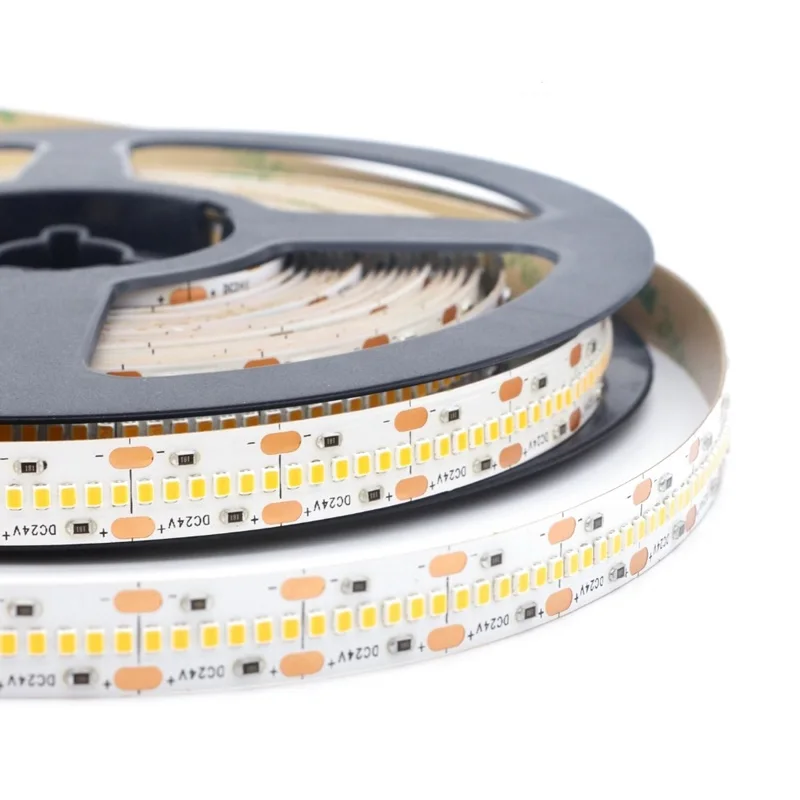
Cinta de luz LED SMD2216
Modelo principal: FWX10T240C
LED CANT. por metro Opción: 120/180/240/300/420
Opción de ancho de PCB: 5mm/10mm
Opción de color: 2700K/3000K/4000K/5000K/6500K
Opción CRI: 80/90
Voltaje de entrada: DC12V/DC24V
Potencia por metro: 9.6W/10W/14.4W/19.2W/20W/24W
Opción de grado IP: IP20/IP54/IP65/IP67/IP68
Garantía: 5 años

Tira de luz LED de larga duración y corriente constante
Modelo principal: FQX10T120D
Opción de metros por rollo: 10m/20m/30m/50m
Opción de ancho de PCB: 10 mm/12 mm
Opción de color: 2700K/3000K/4000K/5000K/6500K
Opción CRI: 80/90
Voltaje de entrada: DC24V/DC36V/DC48V
Potencia por metro: 4,2W/7,2W/8,5W/12W
Opción de grado IP: IP20/IP54/IP65/IP67/IP68
Garantía: 5 años
Cuándo elegir 12V, 24V o 48V Tira de luces LED
Luces de tiras LED de 12 V
Las luces de tiras LED de 12 V funcionan a un voltaje más bajo, lo que significa una corriente más alta para la misma potencia. Este diseño permite intervalos de corte más cortos, generalmente de 25 a 50 mm, lo que los hace perfectos para instalaciones detalladas como estantes de exhibición, detalles de muebles e interiores de automóviles.
Sin embargo, debido a que los sistemas de bajo voltaje son más propensos a la caída de voltaje, los recorridos de más de 5 m sin inyección de energía pueden provocar una pérdida de brillo notable. Esto se debe a la resistencia en los conductores y cableado de la tira, una limitación más pronunciada en 12V que en sistemas de 24V o 48V.


Mejor para:
Corrientes cortas de hasta 5 m sin pérdida de brillo visible
Iluminación decorativa y decorativa en muebles, estantes y espacios pequeños
Sistemas de baja tensión automotriz, marino, de vehículos recreativos y solares
Pros:
- Bajo costo inicial y controladores y atenuadores ampliamente disponibles
- Instalación flexible debido a intervalos de corte cortos
- Fuerte compatibilidad con sistemas basados en baterías de 12V
Contras:
- Caída de voltaje notable en tramos más largos sin inyección de energía
- Menor eficiencia en comparación con los sistemas de mayor tensión para largas distancias
Luces de tiras LED de 24 V
Las tiras de luces LED de 24 V duplican el voltaje de los sistemas de 12 V, cortando la corriente por la mitad para la misma potencia de salida. Esto reduce la acumulación de calor y la caída de voltaje, lo que permite una duración de hasta 10 m sin pérdida de brillo.
El mayor voltaje significa una mejor eficiencia y una iluminación más estable para aplicaciones como la iluminación de la cala del hotel, los estantes minoristas y la iluminación de acento de oficina. Si bien los intervalos de corte suelen ser más largos (50 a 100 mm), lo que limita el recorte ultra preciso, el equilibrio general entre eficiencia, costo y estabilidad de brillo hace que 24 V sea la opción preferida para muchos proyectos comerciales.

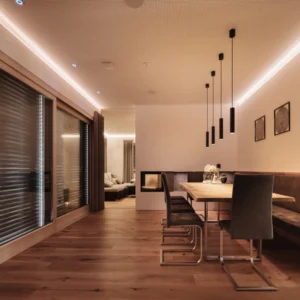
Mejor para:
Instalaciones de longitud media a unos 10 m
Iluminación comercial en hoteles, oficinas y exhibiciones de estantes minoristas
Espacios que requieren brillo constante y un rendimiento de atenuación suave
Pros:
- La corriente más baja reduce el calor y mejora la eficiencia en carreras medias
- Relación de coste-rendimiento equilibrada para la mayoría de las aplicaciones comerciales
- Amplia compatibilidad con controladores de nivel profesional y controladores DMX/DALI
Contras:
- Los intervalos de corte más grandes reducen la flexibilidad en las instalaciones de ajuste ajustado
- Costo inicial ligeramente superior a los sistemas de 12V
Luces de tiras LED de 48V
Las luces de tiras LED de 48 V ofrecen el flujo de corriente más bajo para la misma potencia, minimizando drásticamente la caída de voltaje incluso en distancias de 15 a 20 m o más. Esto permite un brillo uniforme en instalaciones a gran escala, como fachadas de edificios, calas largas o características arquitectónicas al aire libre sin puntos de inyección de energía frecuentes.
La complejidad del cableado reducida y la menor cantidad de fuentes de alimentación reducen los costos de instalación y mantenimiento. Sin embargo, los intervalos de corte son los más largos (100-200 mm), lo que limita el uso en diseños que requieren un ajuste de precisión. Además, los controladores y los sistemas de atenuación compatibles son menos comunes en comparación con las opciones de 12V y 24V.
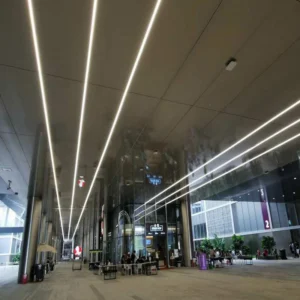
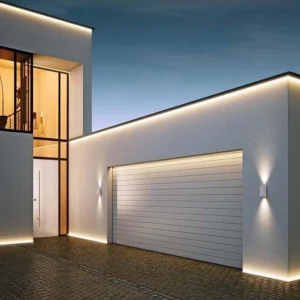
Mejor para:
Instalaciones de larga distancia de 15 a 20 m o más
Iluminación de fachada arquitectónica, calas de techo y grandes proyectos al aire libre
Proyectos comerciales o de ingeniería con el objetivo de minimizar el cableado y las fuentes de alimentación
Pros:
- Corriente más baja entre los tres voltajes, que proporcionan el brillo más estable
- Alta eficiencia energética en largas distancias
- Se requieren menos fuentes de alimentación, lo que reduce la complejidad y el mantenimiento del cableado
Contras:
- Disponibilidad limitada de controladores y controladores compatibles en comparación con 12V/24V
- Los intervalos de corte largos reducen las opciones de personalización en espacios reducidos
Guía de selección de voltaje de tira de LED
| Tensión | mejor para | Longitud máxima | Intervalo de corte típico | Rango de potencia común (W/m) | Pros | Contras |
| 12V | Corridas cortas ≤ 5 m; Iluminación decorativa; Automotriz, Marina, RV, Sistemas solares | ~5 metro | 25-50 mm | 4,8 a 14,4 W/m | Bajo costo; intervalos de corte cortos; alta compatibilidad con sistemas de batería de 12V | Caída de voltaje más alta en recorridos largos; menor eficiencia para distancias prolongadas |
| 24V | Corrientes medianas ~10 m; hoteles, oficinas, estanterías de venta al por menor; atenuación constante | ~10 m | 50-100 mm | 7.2–19.2 W/m | Corriente más baja reduce el calor; buen equilibrio de costo-rendimiento; compatible con conductores profesionales | Intervalos de corte más largos que 12 V; un costo ligeramente más alto |
| 48V | Carreras largas de 15 a 20 m+; fachadas arquitectónicas, grandes proyectos al aire libre | 15–20+ m | 100–200 mm | 10–20 W/m | Corriente más baja, caída de voltaje mínima; mayor eficiencia en carreras largas; menos fuentes de alimentación requeridas | Opciones limitadas de controlador/controlador; intervalos de corte más largos |
*La longitud máxima de carrera se basa en la instalación estándar sin inyección de energía adicional.
Errores que se deben evitar al elegir el voltaje de la tira de LED
Elegir el voltaje de la tira de LED incorrecto puede provocar pérdida de brillo, sobrecalentamiento o retrabajo costoso. Estos son los errores más comunes que se deben evitar:
Uso de tiras de 12 V para largas tiradas sin inyección de energía
Las tiras de LED de 12 V son ideales para recorridos cortos (≤5 m). Usarlos para distancias más largas sin agregar fuentes de alimentación adicionales provocará una caída de brillo visible.
Cortar la tira en la posición incorrecta
Ya sea de 12 V, 24 V o 48 V, siempre corte en las almohadillas de cobre designadas. Cortar en otro lugar puede dañar el circuito y hacer que la tira inutilizable.
Coincidir con el voltaje de la fuente de alimentación incorrecto
Nunca conecte una tira de 12 V a una fuente de alimentación de 24 o 48 V (o viceversa). Esto puede quemar instantáneamente los LED.
Obtenga más información sobre por qué los voltajes que no coinciden pueden dañar sus LED en nuestra guía detallada: Conectar tiras de 12 V LED en una fuente de alimentación de 24 V.
Ignorar los cálculos de caída de voltaje
Para recorridos de más de 5 m (12 V), 10 m (24 V), o 20 m (48 V), calcule la caída de voltaje por adelantado y planee la inyección de energía o los sistemas de mayor voltaje.
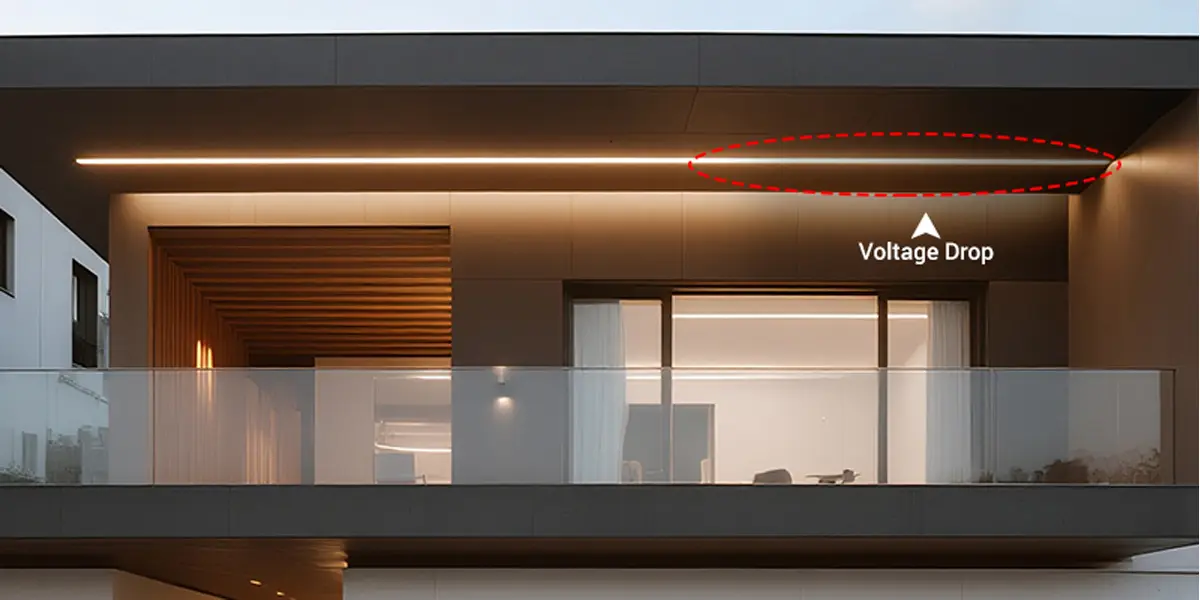
Sobrecarga de la fuente de alimentación
Elija siempre un conductor con al menos 20 a 30% más de capacidad que la potencia total de sus tiras de LED.
Preguntas frecuentes – Selección de voltaje de tira de LED
prohibido . Suministrar voltaje más alto que el tirador para la tira de los LED, causando sobrecalentamiento, daño o falla instantánea. Siempre haga coincidir el voltaje de la tira con el voltaje de la fuente de alimentación.
Para la mayoría de las instalaciones exteriores, se prefieren tiras de LED de 24V o 48V porque permiten recorridos más largos con menos caída de voltaje, lo cual es importante para la iluminación arquitectónica o de fachadas a gran escala.
12V: hasta 5 m sin inyección de energía
24V: hasta 10 m sin inyección de energía
48V: hasta 15-20 m sin inyección de energía
Las tiradas más largas requieren alimentación adicional o cableado paralelo.
Las tiras de LED de 12 V son las mejores para aplicaciones de automóviles, marinas y de RV porque son directamente compatibles con sistemas de baterías de 12 V. Si planea conectar varias tiras de LED de 12 V a una fuente de alimentación, lea nuestra guía paso a paso: ¿Puede conectar varias tiras de LED de 12 V a una fuente de alimentación?
No necesariamente. El brillo depende del tipo de LED, la densidad (LED por metro) y la potencia. El voltaje afecta principalmente a la longitud y eficiencia de la carrera.
Conclusión
La elección del voltaje de la tira de LED adecuado afecta no solo a los resultados de la instalación, sino también a la consistencia del brillo, la eficiencia energética y los costos de mantenimiento.
Cortas cortas e iluminación de precisión: opta por 12 V para corte flexible y compatibilidad con sistemas de batería de bajo voltaje.
Carreras medianas y espacios comerciales: elige 24 V para una combinación equilibrada de rendimiento y costo.
Proyecte largos y proyectos a gran escala: opta por 48 V para minimizar la caída de voltaje y simplificar el cableado.
Para obtener el mejor resultado, considere la duración de la carrera, los requisitos de corte, el diseño de potencia y la seguridad antes de decidirlo; esto garantiza el equilibrio óptimo entre rendimiento, costo y mantenimiento.
Para estimar el uso y eficiencia de energía de su proyecto, consulte nuestra guía completa: ¿Cuánta electricidad usa una tira de luz LED?

